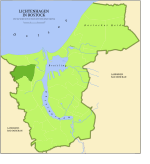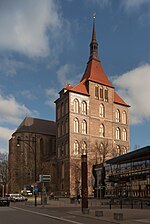Rostock Hauptbahnhof

Rostock Hauptbahnhof, also Rostock Central Station (from 1896 until the turn of the 20th century called Rostock Central-Bahnhof), is the main railway station in the German city of Rostock. It is situated well to the south of the city centre, to which it is linked by tram. The station was opened in 1886 by the Deutsch-Nordischer Lloyd, operating a combined railway/ferry line to Nykøbing Falster in Denmark. The station was expanded in 1913 and 1922, but was heavily damaged in World War II. The importance of the traditional route to Hamburg and Copenhagen diminished after the post-World War II division of Germany, with long-distance services instead focusing on cities within the German Democratic Republic. Electrification reached the station in 1985. After German reunification, the station was extensively modernised.
Excerpt from the Wikipedia article Rostock Hauptbahnhof (License: CC BY-SA 3.0, Authors, Images).Rostock Hauptbahnhof
Albrecht-Kossel-Platz, Rostock Südstadt (Ortsbeirat 12 : Südstadt)
Geographical coordinates (GPS) Address Nearby Places Show on map
Geographical coordinates (GPS)
| Latitude | Longitude |
|---|---|
| N 54.078055555556 ° | E 12.130833333333 ° |
Address
Albrecht-Kossel-Platz
18059 Rostock, Südstadt (Ortsbeirat 12 : Südstadt)
Mecklenburg-Vorpommern, Germany
Open on Google Maps











